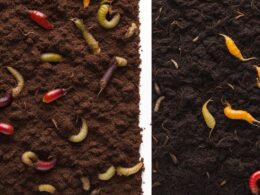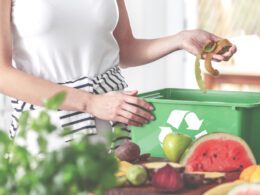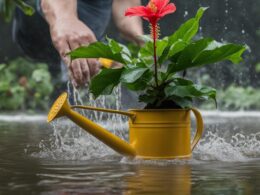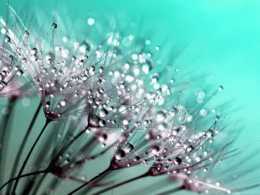Gardening soil and potting soil are two distinct products used for different gardening purposes. Understanding the difference between the two is essential for successful gardening projects. While they may seem similar, there are key variations in their composition and intended use that make them suitable for specific gardening needs.
Key Takeaways
- Gardening soil is designed for outdoor use in garden beds, while potting soil is formulated for container gardening.
- Potting soil does not contain actual soil and is made up of materials like bark and vermiculite.
- Garden soil is heavy and dense, whereas potting soil is lightweight and allows for proper root growth in containers.
- Garden soil should be mixed with native soil in garden beds, while potting soil is best used alone in pots and containers.
- Understanding the differences between these soil types will help you choose the right one for your gardening project.
What is Potting Soil or Potting Mix?
Potting soil or potting mix is a crucial component for successful container gardening. Unlike traditional gardening soil, potting soil does not contain actual soil. It is a specially formulated blend of materials that provide optimal conditions for container plants. This type of soil is designed to be lightweight and porous, allowing for proper root growth, drainage, and aeration.
The composition of potting soil typically includes a mixture of organic matter, such as bark or coconut coir, peat moss, and vermiculite or perlite. These materials help to retain moisture, provide essential nutrients, and ensure proper airflow for the roots. Some potting soils may also contain added fertilizers to support plant growth.
One of the key advantages of potting soil is its versatility. It can be used for a wide range of container plants, including flowers, vegetables, herbs, and even small trees or shrubs. Whether you’re planting in small pots or larger containers, using potting soil ensures that your plants have the necessary nutrients, drainage, and support to thrive.
Benefits of Potting Soil:
- Lightweight and well-draining
- Provides necessary nutrients for container plants
- Allows for proper root growth and aeration
- Retains moisture without becoming waterlogged
- Available in various formulations for different plant types
| Characteristic | Potting Soil | Gardening Soil |
|---|---|---|
| Composition | A blend of organic matter, peat moss, and additives | A mixture of topsoil, sand, and organic matter |
| Texture | Lightweight and well-draining | Heavier and denser |
| Use | Container gardening | Outdoor garden beds |
| Nutrients | Contains added nutrients for plant growth | Naturally enriched with compost |
Using the right potting soil is essential for the success of your container plants. It provides the necessary support, nutrients, and drainage that plants need to thrive in a confined space. So, next time you’re planning to start a container garden, be sure to choose a high-quality potting soil that suits the specific needs of your plants.
What is Garden Soil?
Garden soil is a heavy and dense type of soil that is specifically formulated for outdoor gardening projects. It is designed to provide a stable base for plant roots and prevent excessive root growth.
This type of soil typically contains compost, which is organic matter that has been broken down. The compost in garden soil adds nutrients to the soil and helps to improve its structure. It also retains moisture, which is important for the health of plant roots.
“Garden soil is a great choice for garden beds as it provides a fertile and nutrient-rich environment for plants to thrive.”
Unlike potting soil, garden soil is not meant to be used as a standalone medium. It is best used when mixed with native soil in garden beds. This combination creates a well-balanced soil that is suitable for a variety of plants, including flowers, vegetables, and shrubs.
| Characteristics of Garden Soil | Benefits |
|---|---|
| Heavy and dense | Provides stability for plant roots |
| Contains compost | Enriches the soil with nutrients |
| Retains moisture | Helps plants withstand dry periods |
| Meant to be mixed with native soil | Improves the overall soil structure |
Garden soil is a valuable resource for gardeners who want to establish healthy and thriving garden beds. By understanding its composition and benefits, you can make informed decisions about when and how to use garden soil in your outdoor gardening projects.

When to Use Garden Soil vs Potting Soil?
Knowing when to use garden soil and potting soil is crucial for the success of your gardening projects. Each soil type has its own specific characteristics and advantages that make them suitable for different purposes.
If you’re working on outdoor gardening projects, such as planting flowers, trees, or vegetables in garden beds, garden soil is the better choice. It is specifically designed for this purpose and provides a stable base for plant roots to grow and thrive. Garden soil, with its heavy and dense composition, is ideal for improving the native soil in your garden beds.
On the other hand, if you’re into container gardening, potting soil is the way to go. Potting soil is specially formulated to meet the unique needs of plants grown in containers. Its lightweight composition allows for proper drainage and root movement, ensuring optimal growth. Potting soil also contains added nutrients to support the nutritional needs of container plants.
Factors to Consider
When deciding whether to use garden soil or potting soil, consider the following factors:
- The type of gardening project: If you’re working on an outdoor garden bed, garden soil is the most appropriate choice. For container gardening, potting soil is the better option.
- The type of plants: Some plants, such as flowers and vegetables, thrive in garden beds and require the use of garden soil. Other plants, like potted houseplants, require the use of potting soil to ensure proper drainage and nutrition.
- The location: If your gardening project is indoors or on a balcony, where containers are the primary growing space, potting soil is essential. For outdoor gardens, garden soil is the better choice.
By considering these factors, you can determine whether to use garden soil or potting soil for your specific gardening projects. Remember, using the right soil type is essential for providing the optimal growing conditions and ensuring the health and vitality of your plants.

Understanding the Differences: Garden Soil vs Potting Soil
When it comes to gardening, choosing the right soil is crucial for the success of your plants. Two common options are garden soil and potting soil, each with its own unique characteristics. Let’s delve into the differences between these two soil types and understand when to use them.
The Composition:
Garden soil is heavy and dense, designed to be mixed with native soil in garden beds. It typically contains compost, providing essential nutrients for plant growth. On the other hand, potting soil is specifically formulated for container gardening. It does not contain actual soil but is a blend of materials like bark and vermiculite. Potting soil is lightweight and allows for better drainage in containers, preventing root rot.
The Intended Use:
Garden soil is ideal for outdoor gardening projects, such as planting flowers, trees, and vegetables in garden beds. It provides a stable base for plant roots and improves the structure of native soil. Additionally, garden soil can be enriched over time as its organic components break down. On the contrary, potting soil is best suited for container gardening. It provides all the necessary nutrients for plants in pots or containers, ensuring optimal growth and nutrition.
Characteristics:
When comparing garden soil and potting soil, their key characteristics become evident. Garden soil is heavier and denser, while potting soil is lighter and allows for proper root growth and movement in containers. Garden soil contains natural compost, whereas potting soil has added nutrients to support plant growth. Both soil types have their benefits and advantages, depending on your specific gardening projects.
By understanding the differences between garden soil and potting soil, you can make informed choices for your gardening needs. Whether it’s enhancing your garden beds or nurturing container plants, selecting the right soil will contribute to the health and prosperity of your plants.
Is a Soil Tester Necessary for Potting Soil as Well?
When it comes to potting soil, many gardeners wonder if it’s necessary to use a soil tester. While some may argue that experienced gardeners can gauge the soil’s condition by sight and touch, using a soil tester provides accurate results. By analyzing pH levels, moisture content, and nutrient levels, a soil tester helps determine the specific needs of the potting soil, ensuring optimal plant growth.
Conclusion
Understanding the difference between gardening soil and potting soil is crucial for the success of your gardening projects. Garden soil is best suited for outdoor gardening, as it improves the native soil and provides a stable foundation for plant roots. On the other hand, potting soil is specifically formulated for container gardening, providing lightweight and well-draining conditions for your plants.
When choosing between gardening soil and potting soil, consider the specific needs of your project. If you’re planting flowers or vegetables in garden beds, garden soil mixed with native soil will be your best bet. However, if you’re utilizing pots or containers, potting soil will provide the necessary nutrients and excellent drainage that container plants require.
Both gardening soil and potting soil have their own unique characteristics and benefits. By selecting the appropriate soil type for your gardening endeavors, you’ll ensure optimal plant growth and health. So, whether you’re working on an outdoor garden or a container-based project, make sure to choose the right soil for the job. Happy gardening!
FAQ
What is the difference between gardening soil and potting soil?
Gardening soil is designed for outdoor use in garden beds, while potting soil is specifically formulated for container gardening.
What is potting soil or potting mix?
Potting soil is a blend of materials such as bark, vermiculite, and drainage enhancers. It does not contain actual soil and is lightweight, providing optimal root growth and movement in containers.
What is garden soil?
Garden soil is heavy and dense, containing compost. It is meant to be mixed with native soil in garden beds, providing a stable base for plant roots and preventing excessive root growth.
When should I use garden soil vs potting soil?
Garden soil should be used for outdoor gardening projects in garden beds, while potting soil is specifically designed for container gardening in pots and containers.
What are the differences between garden soil and potting soil?
Garden soil is heavier and denser, while potting soil is lightweight and allows for better drainage in containers. Garden soil contains compost and is meant for mixing with native soil, while potting soil has added nutrients and is used as a standalone medium.









